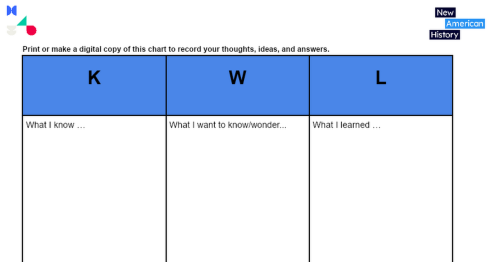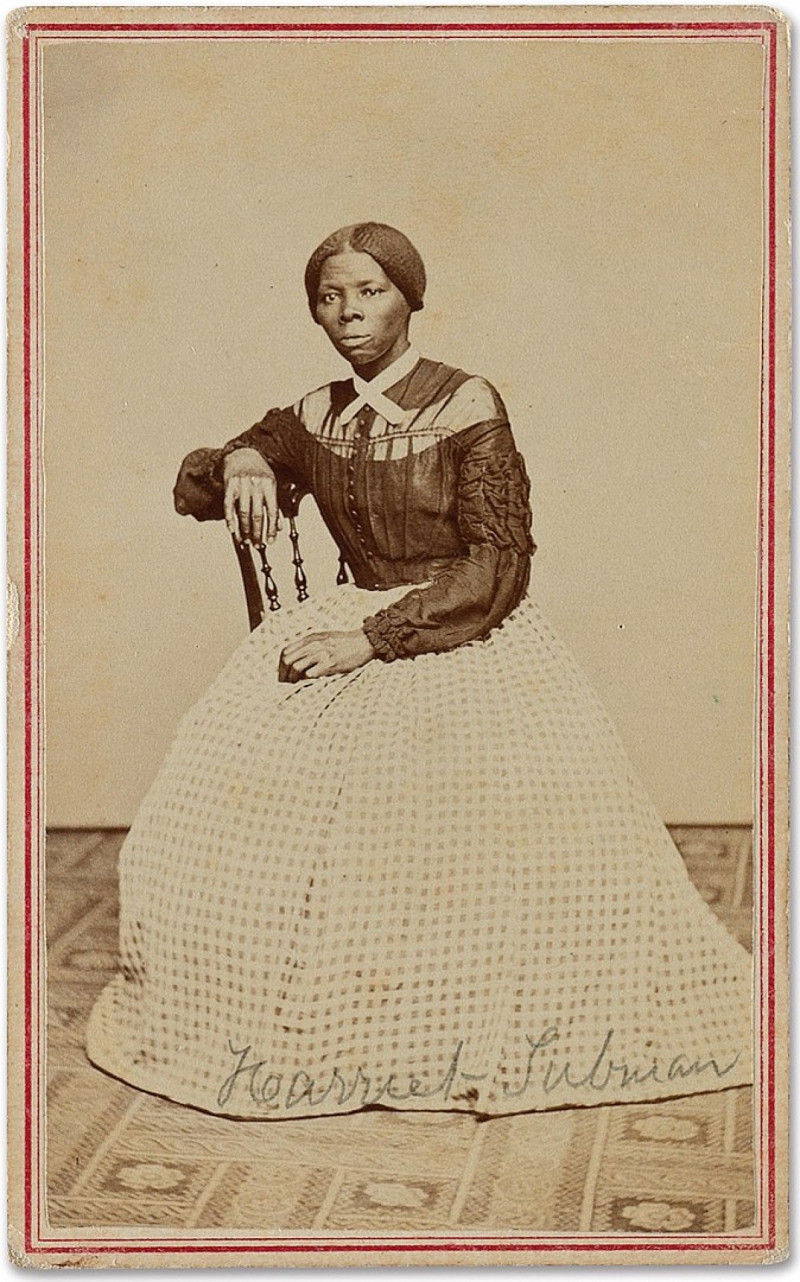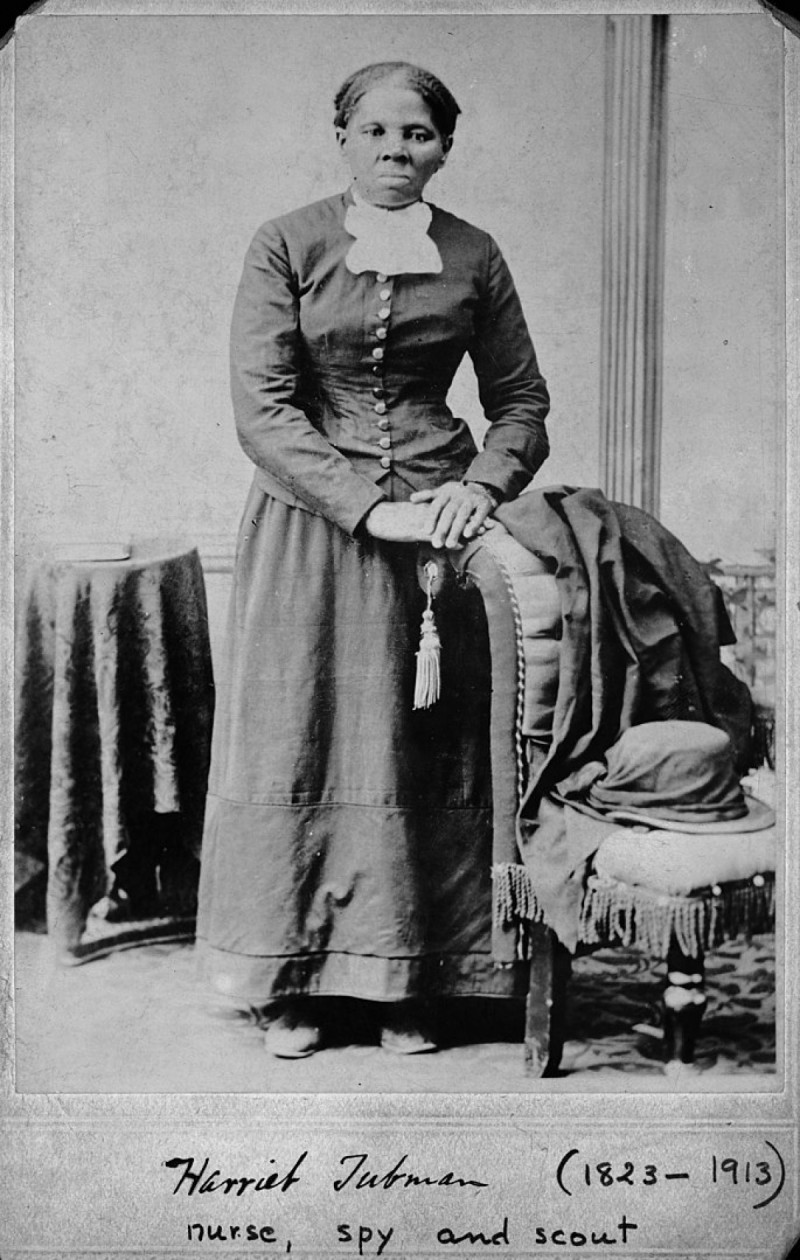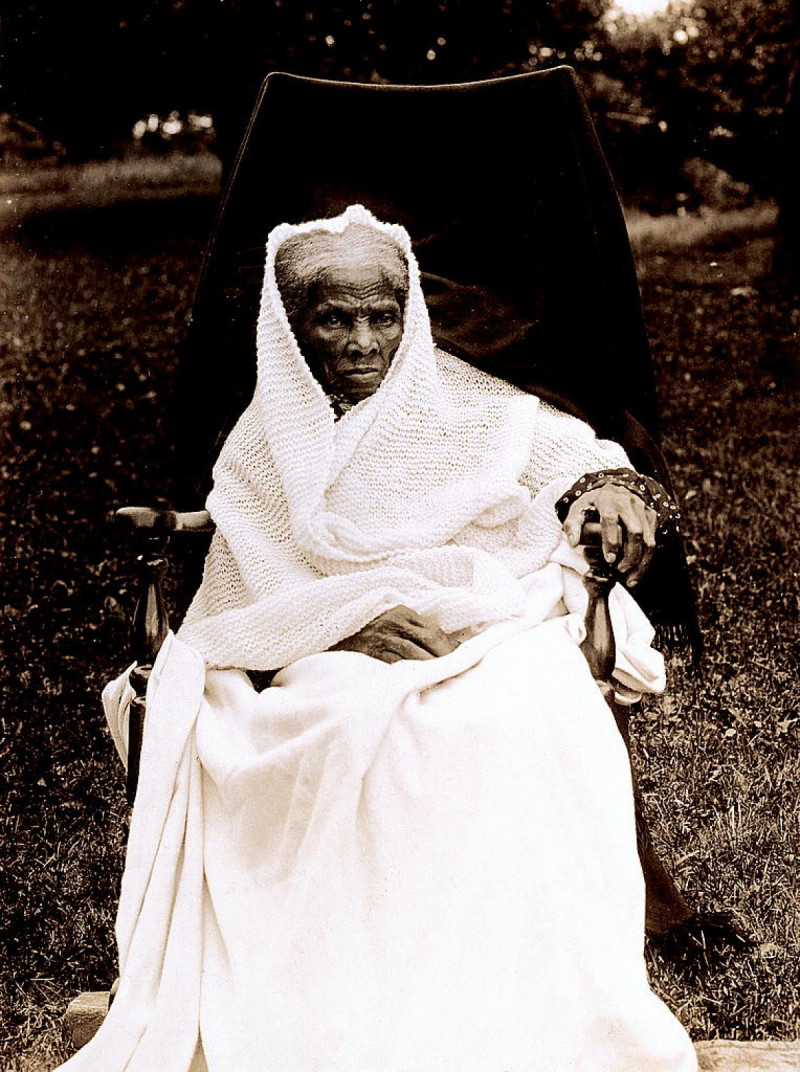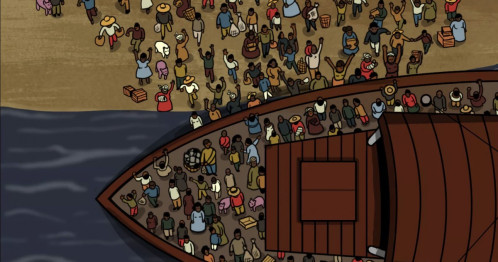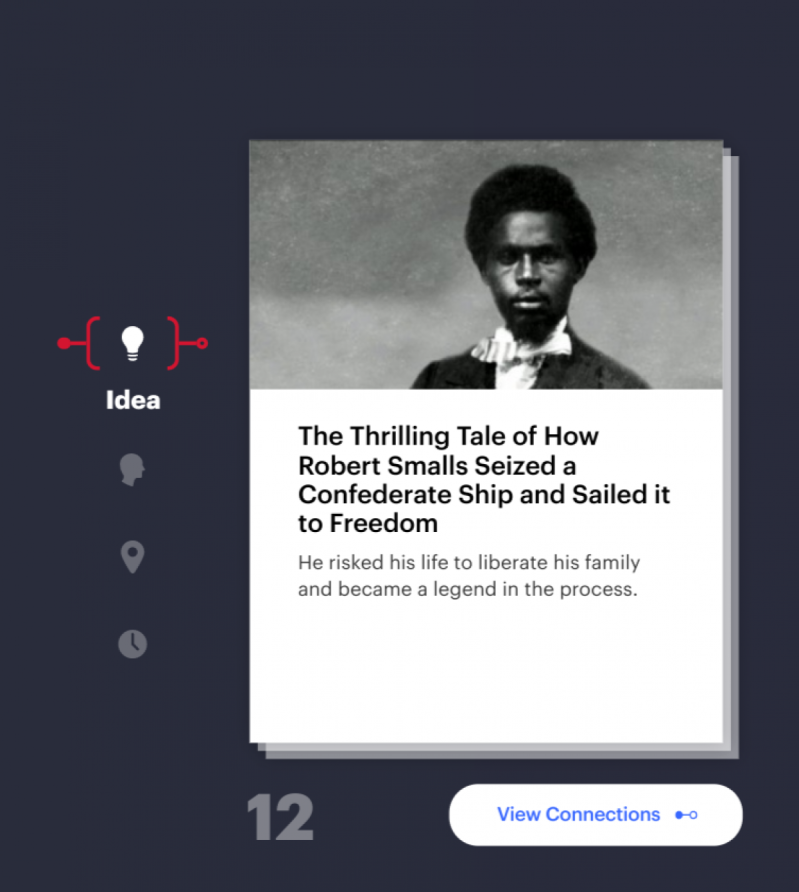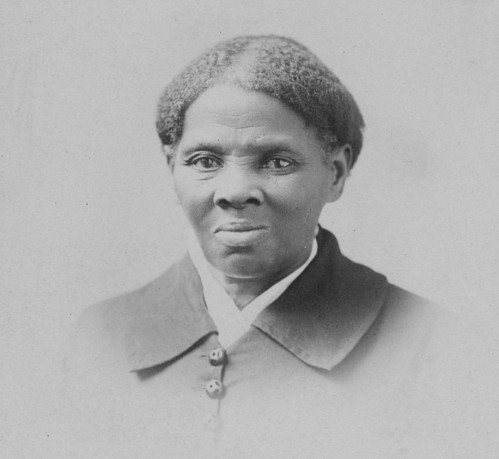This work by New American History is licensed under a Attribution-NonCommercial-ShareAlike 4.0 (CC BY-NC-SA 4.0) International License. Permissions beyond the scope of this license may be available at newamericanhistory.org.
Harriet Tubman
Read for Understanding
Harriet Tubman is remembered as an enslaved African American woman who was an abolitionist, a “conductor” on the Underground Railroad, and a Union spy during the American Civil War. As a child she was called “Minty,” but later she was called “Moses” referring to the biblical character who helped set others free. The exact number of slaves she helped escape to the north, including some of her own family members, is unknown and has in some cases probably been exaggerated. Tubman suffered from health issues related to an injury which some believe may have been a form of epilepsy.
Key Vocabulary
Abolish - to end, get rid of, no longer recognize as legally bound
Abolitionist - a person actively working to end slavery
Enslave - to force someone to be a slave, losing their freedom of choice or action
Emancipation - being set free from legal, social, or political restrictions; liberation
Underground Railroad - A system of cooperation among abolitionists in the U.S. before 1863 to secretly assist fugitive slaves reach the North or Canada
Engage:
What do we really know about Harriet Tubman?
Harriet Tubman continues to be one of the most recognizable historical figures, yet many people still seem to debate the myth versus reality of her contributions in American history.
Use the KWL chart provided by your teacher, or make a copy of the Google Doc version using the link provided below.
Use the KWL chart provided to list your thoughts in the first and second columns, Know and Want to Know / Wonder. Take a few minutes to share your chart with a partner. If working remotely, use the chatbox or another collaboration strategy such as Google Docs or Google Slides, as recommended by your teacher.
- Do you share any common ideas or questions with your partner?
- Place a check mark next to your shared thoughts in each column.
- Join another pair of classmates and continue to compare your KWL charts.
- Are there any ideas or questions between the 4 charts that do not seem to be in agreement with one or more ideas on other classmates’ chart?
Your teacher may ask you to record your thoughts about working on the KWL chart with a partner using an exit ticket.
Explore:
What word best describes Harriet Tubman?
Harriet Tubman was photographed most often toward the end of her life, but in the spring of 2019, a rare image of Harriet was discovered and shared by the Smithsonian National Museum of African American History and Culture.
This image of a younger Harriet Tubman is believed to have been taken in 1868-69 when she was approximately 40 years old.
- What word(s) would you use to describe this image of Harriet?
- Turn and talk to a partner about the word(s) you selected to describe the image. Why did you select these words? (If working remotely, use the chatbox or another collaboration strategy such as a Google Doc, as recommended by your teacher.)
- Did you and your partner have similar adjectives to describe the image?
- How did your words differ?
The two images above were taken later in Tubman's life, when she was approximately 50 years old and 90 years old.
Now study the images of Harriet taken during these later times in her life.
- What new information about Harriet do these images reveal?
- What words might you use to describe the image of middle-aged Harriet vs. Harriet later in life?
- What new information about Harriet do these images reveal?
- Compare your ideas with your partner.
Historians use primary sources such as documents, artifacts, and images to uncover clues about the past. Take a closer look at the images, including any written details in the image.
- How do these clues provide more information?
- What do you notice about the coloration of the images?
- How do photographs from the past differ from modern photographic tools and images?
- Where might you find more information about the people, objects, and text in the images?
Your teacher may ask you to record your answers on an exit ticket.
Explain
Do history books teach us about the real Harriet Tubman, or do we just think they do?
Read this Bunk excerpt (a section or portion) of a comic about Harriet Tubman.
- Does this excerpt seem to be from the beginning, middle or end of the story?
- What clues help you understand or decide where the excerpt might belong in the story?
- What clues do the images provide about Harriet Tubman, the time period or setting of the story?
- What questions do you still have about the story?
Now read the comic in its entirety by selecting the View on the Nib button at the end of the excerpt. Once you have read the entire comic, return to the Bunk website and select the View Connections button.
Take a few minutes to explore the icons, tags, and cards.
- What happens to the gray number when you select a different connection icon?
- What happens to the stack of cards?
Select How Connections Work and Learn More about the different types of connections you can make in Bunk. Use the back arrow in your browser to return to the excerpt you read about Harriet Tubman.
- What are some of the tags you see as you select different connections?
Select an icon and click on one of the connected cards. Read the excerpt from the card on your own. Note the icon, tags, and number of connections for the excerpt you selected.
When you finish reading the excerpt, discuss and summarize the article with a partner who selected a different connection icon. If working remotely, use the chatbox or another collaboration strategy such as Google Docs or Google Slides, as recommended by your teacher.
- Did either excerpt mention or include new information specifically about Harriet Tubman?
- How were the articles connected to the original comic you read earlier?
- Did any of the information in either article agree or disagree with factual information about Harriet Tubman, the Underground Railroad or other topics from the comic?
- If so, how might you find more information about the topic to help clarify which version is more accurate?
- What new tags might you add to one or more of the connections you viewed between the Bunk articles.
Go back to the KWL chart you made earlier in the lesson. In the third column, labeled “L” for What I Learned, add any new facts you have learned about Harriet Tubman, the Underground Railroad, and life before, during, and after the Civil War. Compare your chart and results with your partner.
Your teacher may ask you to record your thoughts about working on the KWL chart with a partner using an exit ticket.
Elaborate:
How should we remember and honor Harriet Tubman?
BackStory is a weekly podcast (digital audio program) where a group of historians discuss new ideas to consider about people, places, and events in history. Occasionally BackStory will also feature new content on their blog (an online journal or informational website).
This blog entry discusses Harriet Tubman Day, an annual celebration of the famous abolitionist. As you read the blog, note any new information you learn about Harriet Tubman on your KWL chart.
Read the blog on BackStory. Learn more about Harriet Tubman Day.
Share your KWL chart with a partner. If working remotely, use the chatbox or another collaboration strategy such as Google Docs or Google Slides, as recommended by your teacher.
- Did you note any new information about Harriet Tubman from the blog which agrees or disagrees with earlier information you learned either from The Nib comic, or one of the Bunk History excerpts you read?
- Which of these sources did you find most interesting? (The Nib, Bunk or BackStory?) Explain your answer with your partner.
- Of the 3 resources you used today, which do you think tells the most accurate version of Harriet Tubman’s life and accomplishments? Discuss your thoughts with your partner.
Your teacher may ask you to record your thoughts about working on the KWL chart with a partner using an exit ticket.
Extend:
How will you share the story of inspiring Americans like Harriet Tubman?
View this TED-Ed animation from educator Janell Ross and animator Yan Dan Wong.
Create your own blog entry, comic, video or brief podcast in which you discuss or illustrate how you think one should or should not remember and honor Harriet Tubman. You may work in pairs with your partner or independently. Share your work with your class, school or community when you are finished. If working remotely you may share via Google Docs or Slides, or using a digital platform approved by your school such as Canvas or SeeSaw.
Here are some helpful sites to help you get started:
- Student blogs: https://www.kidscodecs.com/online-guidelines-for-student-blogging/
- Comics: https://www.storyboardthat.com/storyboard-creator
- Student podcasts: https://www.commonsense.org/education/top-picks/best-podcast-apps-and-websites-for-students
- Student videos: https://app.biteable.com
Your teacher may ask you to record your answers on an exit ticket.
Citations:
Bunk History. (2019). Harriet Tubman’s Daring Civil War Raid.[online] Available at: https://www.bunkhistory.org/resources/3615.
Hobson, Janell. 2018. "The Breathtaking Courage Of Harriet Tubman". Youtube. https://www.youtube.com/watch?v=Dv7YhVKFqbQ.
Hunter-Chang, Gabriel. “Harriet Tubman Day.” BackStory. Virginia Humanities. Accessed March 10, 2018. https://www.backstoryradio.org/blog/harriet-tubman-day/.
Keyes, Allison. “A Previously Unknown Portrait of a Young Harriet Tubman Goes on View .” Smithsonianmag.com. Smithsonian Institute, March 26, 2019. https://www.smithsonianmag.com/smithsonian-institution/previously-unknown-portrait-abolitionist-harriet-tubman-young-woman-goes-view-180971796/.
Lindsley, Harvey B, photographer. Harriet Tubman, full-length portrait, standing with hands on back of a chair. , ca. 1871. [Between and 1876] Photograph. https://www.loc.gov/item/2003674596/.
Saunders, Chelsea, and Tristan J. Tarwater. “Harriet Tubman's Daring Civil War Raid.” The Nib. The Nib, December 17, 2018. https://thenib.com/harriet-tubman-s-daring-civil-war-raid.


